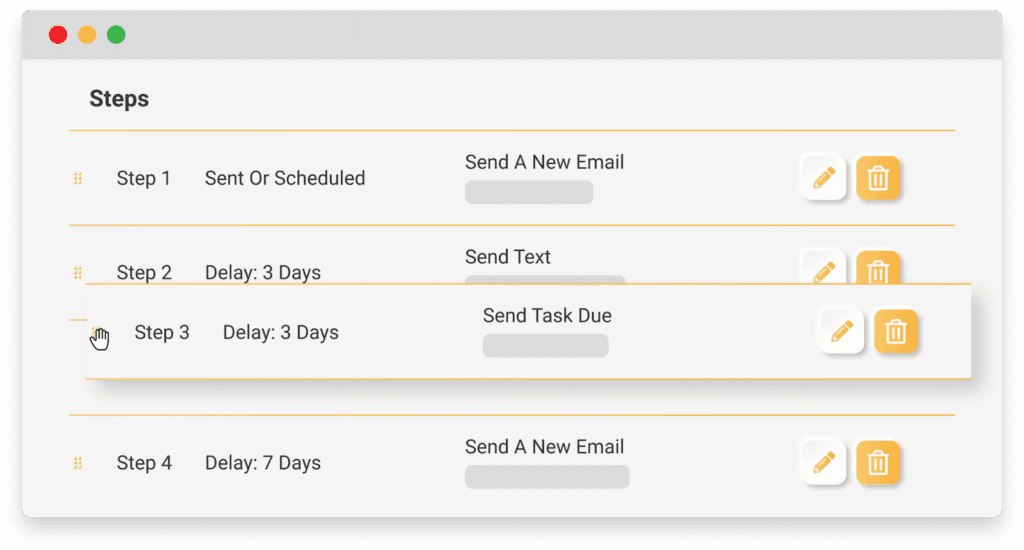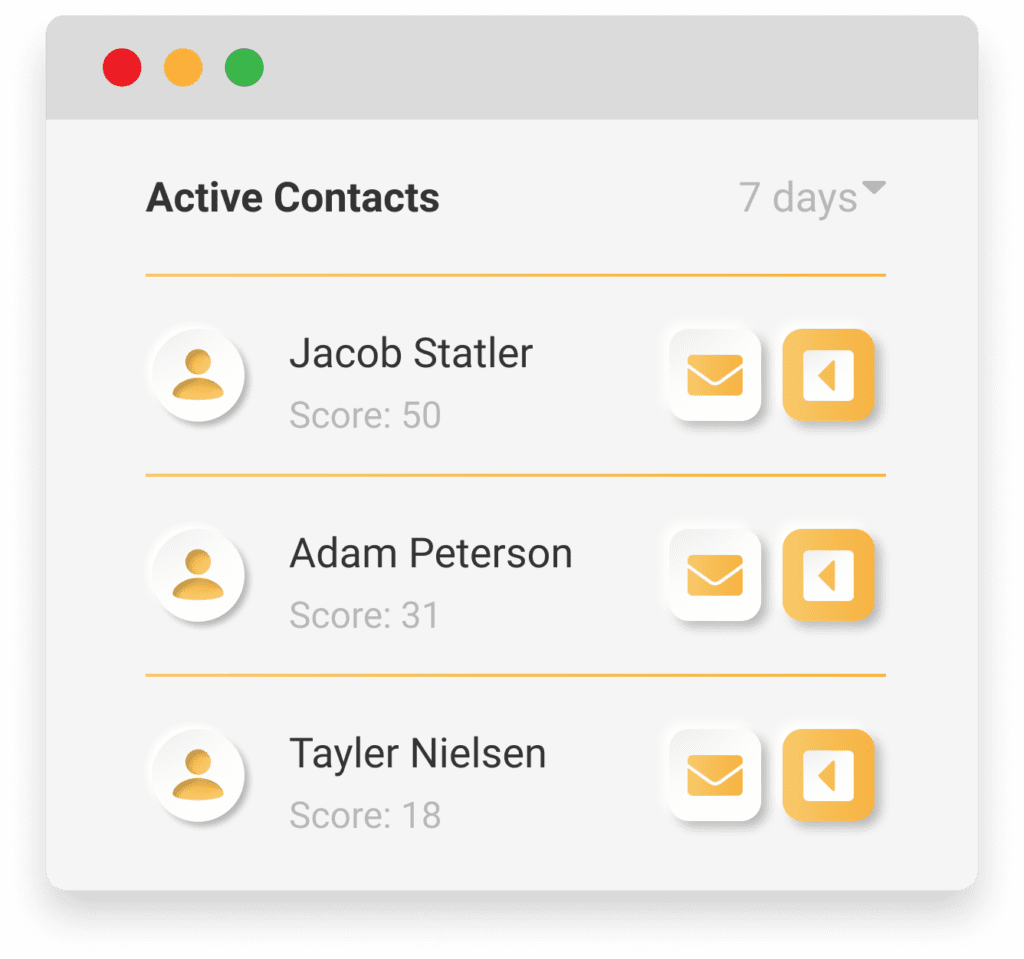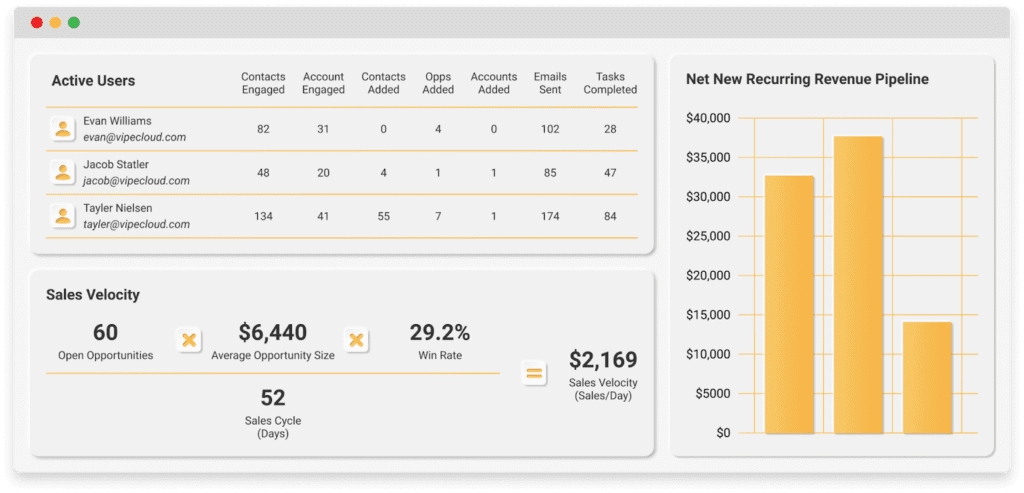Last updated on August 7th, 2023

CRM comes with more capabilities than you may think. The CRM examples in this guide will help you choose features that fit your business.
CRMs can differ and it’s more than a difference in the pricing model or industry-specific solutions.
Today we’ll go over primary features you can expect from the 4 different types of CRM.
These range from all-in-one systems that were made with versatility in mind to ones with specific use-cases for analytics.
Table of contents:
- What Is A CRM Tool Exactly?
- What Are Examples Of CRM Software?
- What Example Of CRM Is Best For My Business?
- What Is The Best Operational CRM In The Market?

VipeCloud is the only Automation tool your small business needs to
be the hero to your customers.
With Email, Texting, Social, Suites, Chat, Stories, Video Email & Sign Up Forms fully built-in, we provide you with the perfect platform to grow your business.
15 Day Free Trial – Get started risk free. No CC needed.
What Is A CRM Tool Exactly?
CRM is a software tool that helps companies build better and lasting customer relationships.
Internally, it improves your company processes with tools that boost effectiveness and efficiency.
CRM offers analytical insights, data, and customer journey information to make decision-making easier and touchpoints even smarter.
A major building block of creating better customer relationships is the customer experience (which begins when someone is entering the awareness stage).
CRM offers pipelines, automation, and segmentation capabilities to make the customer experience personalized.
To improve your internal processes, CRM offers task reminders, lead scoring, and scheduling to facilitate day-to-day operations.
Overall, everything I just stated covers CRM’s function in general.
But believe it or not, CRMs can get more “specialized,” making them more adaptable to specific needs and business models.
What Are Examples Of CRM Software?
There are different types of CRM software to consider before an investment.
However, some CRM software can cover all types as an all-in-one solution.
Operational CRM (All-In-One)

An operational CRM is a versatile application covering all the internal and customer-facing needs of a business.
With operational CRMs, you’ll find tools for marketing, sales, data insights, and customer service.
It’s the ultimate way to combine and connect your business’s tech stack, which beats the need to have your software decentralized.
In operational CRM, you’ll find data to be securely stored, and business activities recorded, giving a birds-eye view of all your moving parts.
It’s not uncommon for this form of CRM to be highly recommended since you run less of a risk of a missing feature.
In today’s age, operational CRMs have become more affordable, leading to more small businesses and solopreneurs adopting them.
In fact, roughly 50% of businesses with less than 10 employees use CRM software.
As far as examples go, VipeCloud’s Sales & Marketing Suite is a case in point.
VipeCloud is a cloud-based CRM that brings versatility thanks to its tools like:
- Lead scoring
- Forms
- Email marketing
- Pipelines
- Scheduling
- Analytics
- Integrations
- Tasks
- Social sharing
- Integrations
And much more.
So what’s the main takeaway?
HINT: It’s not to think you HAVE to use all the tools.
It’s about focusing on the main tools that give you the most leverage and ROI based on time spent.
For instance, a consultant that gets most of his leads from LinkedIn can focus on scheduling his content using VipeCloud’s social sharing tool rather than spreading himself thin using SMS.
But if he’s struggling to keep up with client communication, then using SMS could be a feature he adds to this process later.
The good news?
All-in-one CRMs grow with your business!
So if there comes a time when you need more feature capabilities, they’ll be there or simply a tier package away.
Sales CRM

Sales CRMs bring sales automation and enablement tools to make selling more effective and efficient.
And when paired with good sales approaches, it can drastically improve a company’s ability to win sales opportunities.
And don’t forget how well it helps sales teams better manage customer touchpoints, journeys, and the sales process.
One of the more significant components of your sales CRM is your pipeline.
A sales pipeline helps give a macro view of your sales cycle.
They also provide sales analytics that gives you raw data on deals and decisions you’ve made.
Here are other tools you can find:
- Sales reporting
- Lead scoring
- Lead distribution
- Contact data (company, name, journey, etc.)
- Task management
- CPQ
This CRM type is excellent for companies that already have a robust inbound lead system and need a way to manage incoming deals at scale.
Remember:
Sales CRMs tend to come with some marketing capabilities but not at the same level as operational CRMs.
If you’re wondering, VipeCloud also falls into the sales CRM category since it can be used solely for that purpose.
VipeCloud gives its end-users a competitive edge, especially thanks to robust reporting capabilities.
Analytical CRM

Analytical CRMs help you collect various types of data that can help you make better data-backed decisions.
This is data that can be pulled from your marketing channels, customer insights, sales numbers, and much more.
Analytical CRMs open the door for a thorough interpretation of your data, which helps you make the right decisions year-in and year-out.
In other words, the result is better business outcomes due to better decision-making.
For instance, a win rate that doesn’t meet your standards (data) can be improved by evaluating your sales cycle and updating your sales enablement resources (decision).

Here’s the kind of data that are commonly tracked with analytical CRMs:
- Website activity
- Sales volume
- Marketing channel activity
- Marketing efforts
And here are some benefits:
- Better forecasting
- Marketing optimization
- Product/service improvement
- Improved sales & customer analysis
- Loyalty analysis
- Improved campaign planning
- Better customer experience
Some companies designate a CRM analyst, whose’ responsibilities are to track and draw conclusions from data.
But you don’t have to hire one to get clear insights into your data.
VipeCloud offers helpful analytics when it comes to sales and marketing efforts.
And with this information, you can undergo these 4 simple steps to analyze the information:
- Descriptive Stage – What’s the data show?
- Diagnostic Stage – Why is it happening? (Is it caused by your actions or things you can’t control?)
- Predictive Stage – What’s likely to happen in the future?
- Prescriptive Stage – What needs to get done? (action-items to reach goal)
For example, say you’re using email as your marketing medium.
Your metrics could show a better open and click-through rate when using a question-based subject line compared to a statement.
Another example could be your forms.
Let’s say you’re driving traffic to two separate forms (with the same offer).
Perhaps the form with 4 fields tends to get more sign-ups than the one with 6 fields. From there, you’ll know to keep forms to just 4 fields.
It’s analytical feedback like this that powers your higher-revenue decision-making.
Collaborative CRM
A study found that 86% of respondents believe strong customer service turns one-time clients into long-term brand champions.
Champions are powerful since they advocate for you (like good salespeople that you don’t have to pay).
Strong customer service is achieved through information sharing, which brings us to collaborative CRM.

Collaborative CRMs collect, organize and share customer data.
This allows information to be shared across multiple departments.
The primary goal?
Facilitate customer satisfaction and, of course, retention.
So collaborative CRMs give you tools that make serving customers simpler for team members.
They can include:
- Multi-channel engagement
- Customer journeys
- Purchase history
- Sales data
- Support management
Collaborative CRMs improve the impact of different company roles by giving seat members unified information.
A great use-case could be using the information submitted into lead forms created by your marketing department to power your sales approach.
Your sales team can ask follow-up questions based on the qualification questions that were answered on the form (by your prospect).
Fortunately, VipeCloud makes this easy thanks to its form builder and its ability to sync explicit customer information onto each contact.
Another use-case of collaborative CRM is sharing the preferred platform customers want to be engaged on with customer service reps.
Maybe you’ve found high engagement with text message campaigns when it comes to a customer segment.
With this in mind, your customer service agents can engage website chatbot questions not only on the chatbot but via text from your CRM also.
So the big picture is collaborative CRMs bring customer engagement to the forefront without sacrificing efficiency.
What Example Of CRM Is Best For My Business?
Businesses come with different needs, so when choosing the right CRM, you have to start with what’s needed.
For starters, think about how you handle marketing and how well you know your target market.
Think:
- Who are they?
- What do they struggle with?
- Where do they hang out?
- How does my product help them?
- How do I convey my product as valuable and worth the investment?
- What marketing KPIs matter most?
- How do I currently market, and how can it be improved? (automated, segmented, new platform, etc.)
Thinking in this way will help pinpoint if going with an operational CRM is ideal (thanks to its marketing functions).
When it comes to sales, you can think:
- What’s my sales process?
- What tools do I need to help win more deals?
- How do I handle leads once they enter my pipeline?
- How am I distinguishing high-priority leads from low-priority ones?
- What channels should my sales team follow up on?
- How am I using sales data to power my decision-making process?
When we jump over to the customer service side of your business, the focus should be on customer satisfaction. (The bread and butter of this comes down to solving problems.)
Here are some customer service questions that can help you choose the right CRM type.
- What tools do I need to solve customer inquiries effectively and at scale?
- How can I use my customers’ marketing and sales data to serve their needs better?
- What disconnect or “gaps” am I seeing with my customer service process?
- Is my internal team on the same page for different customer inquiries? If not, why? And if so, where can improvement be made?
If you find that business gaps are minuscule and just need a CRM that interprets your analytics, then an analytical CRM might be the correct route.
On the other hand, if marketing and sales are helping you scale well, yet customer service is lacking, then a collaborative CRM may be the best idea.
But more often than not, it’s the operational CRM that most businesses choose since it has the capabilities of both analytical CRMs and collaborative ones.
And the best part?
Operational CRMs grow with your business. Meaning that versatile integrations are handy as your business needs change.
With that said, it begs the question:
“If all-in-one (operational) CRMs are ideal, then which is the best one to adopt?”
What Is The Best Operational CRM In The Market?
If you’re looking for the ideal operational CRM solution, then VipeCloud is your answer.
You’ll gain access to features like:
And many more that move the needle in your marketing, sales, and customer service.
VipeCloud also offers resources that assist your implementation such as:
- Demos
- A CRM use-case page on the website
- CRM success blog with a library of content
- Free migration to get you started on the right foot
At the end of the day, all-in-one CRMs match your different business needs, so VipeCloud keeps this in mind when adding new features continuously.
So are you ready to get started?
Then try VipeCloud’s Sales & Marketing Suite today, 15 days for FREE.
If you have questions about your implementation, one of our experts can answer them while walking you through the CRM when you request a demo.
CRM Examples FAQ
There are four different types of CRM solutions, such as operational (all-in-one), sales, analytical, and operational.
Spreadsheets made in Excel are popular and easy to use. With the aid of database functions, it enables you to gather data and information and manage, analyze, and evaluate them. Because of this, it can be used as a CRM. You can create a table with several tabs and formulas to sort and analyze customer data.
No, learning to navigate the CRM platform is not difficult. It’s an easy-to-use tool that helps you to track your marketing and sales activities so you can optimize your efforts.

Leave a Reply